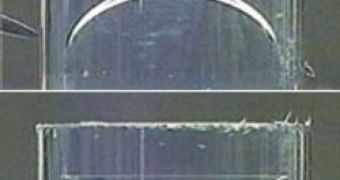Lenses are used to converge or diverge light in various optical and electronic devices and the first written records of the use of a lens date to Ancient Greece, in 424 BC. The optical zoom lenses in professional television cameras can have a magnification ratio as high as 100x.
Constructing a lens that does not change focus with the same image quality as one that does is pretty hard, and requires moving parts to alter its position inside the device.
Now, a German research team came up with the first liquid camera lens that doesn't use any moving parts to switch between two levels of magnification, leading the way to liquid zoom lenses that can sweep through a range of magnifications.
A liquid lens works by using the curved boundary between oily and watery liquids, which can me made to curve in a way that focuses light and oil; all it takes is the right voltage and two liquids in the right container.
Having the advantage of being smaller than solid lenses and much cheaper, they are now used in some optical devices and even in some cellphones, where they can alter the focusing power as efficiently as the traditional fixed-focus lenses.
These liquid lenses work by applying an electrical current through a liquid that repels the watery solution, but not the oil, which makes the walls of the cylinder less water repellent, thus changing the distribution of the two fluids in the lens and causing the curve to flatten out, changing its focal length. When the four liquid lenses inside the new device are most curved, the optics offer a magnification of 2.5 times.
"That would remove the need for mechanical parts, which would be a major advantage," says Peter Schreiber, a researcher at the Fraunhofer Institute for Applied Optics and Precision Engineering, Jena, Germany.

 14 DAY TRIAL //
14 DAY TRIAL //